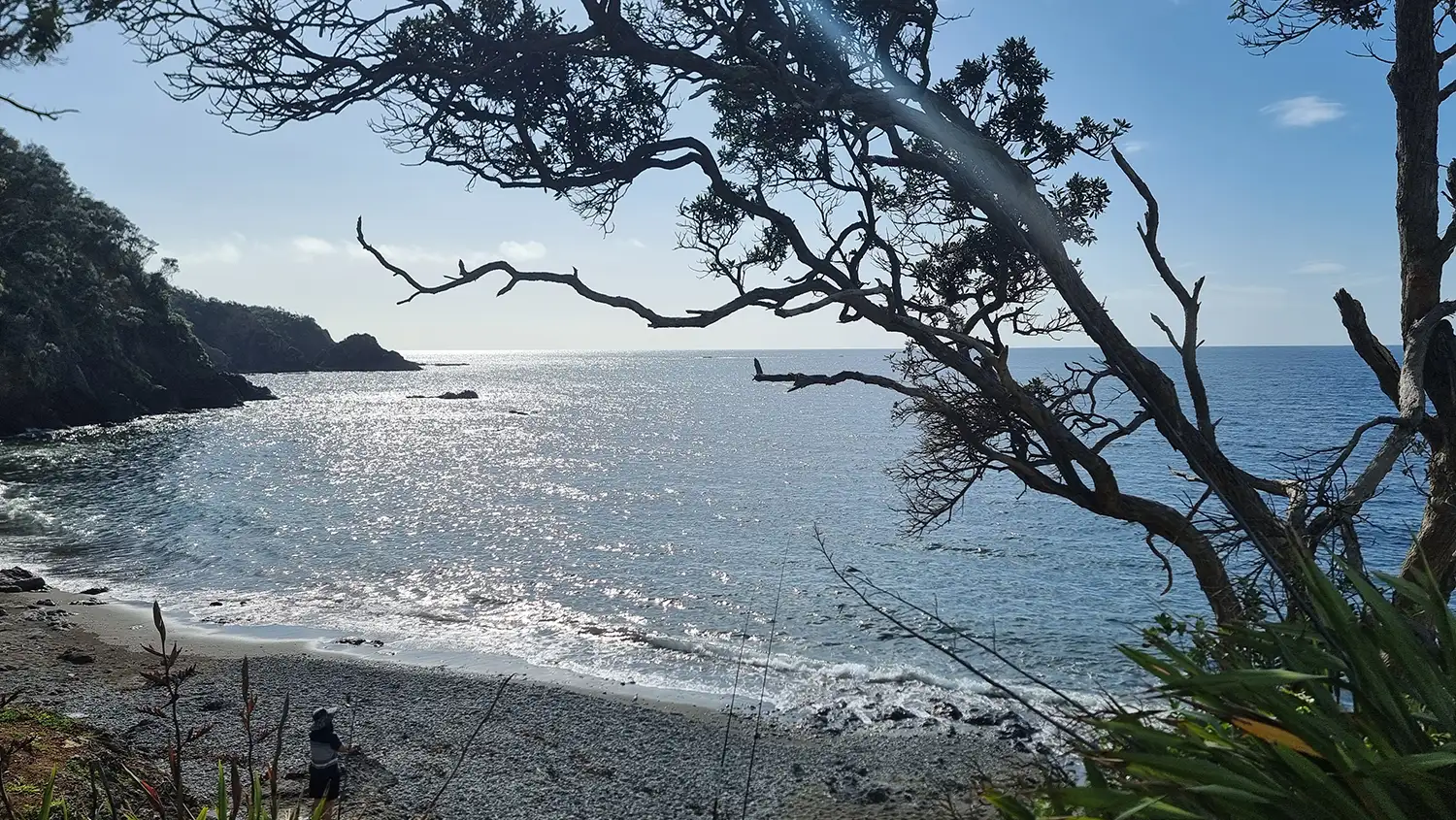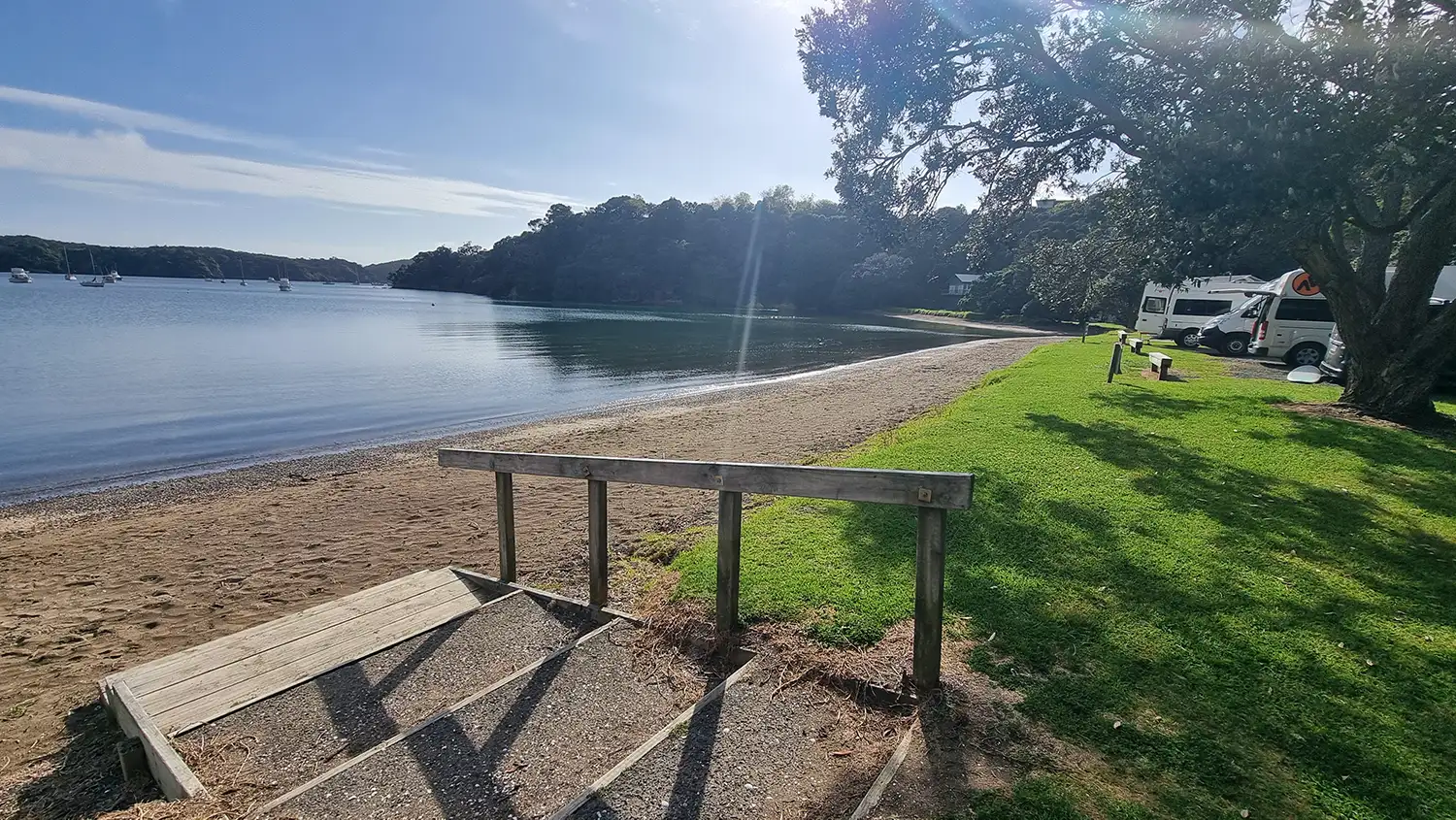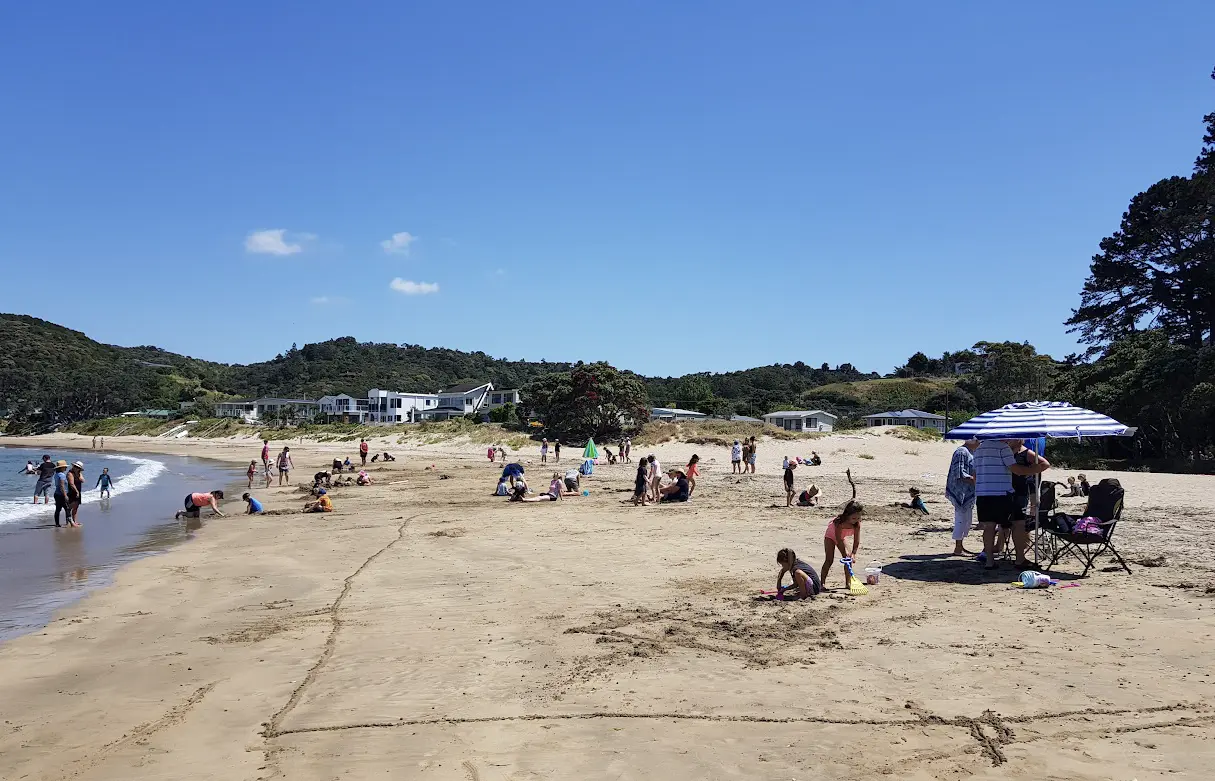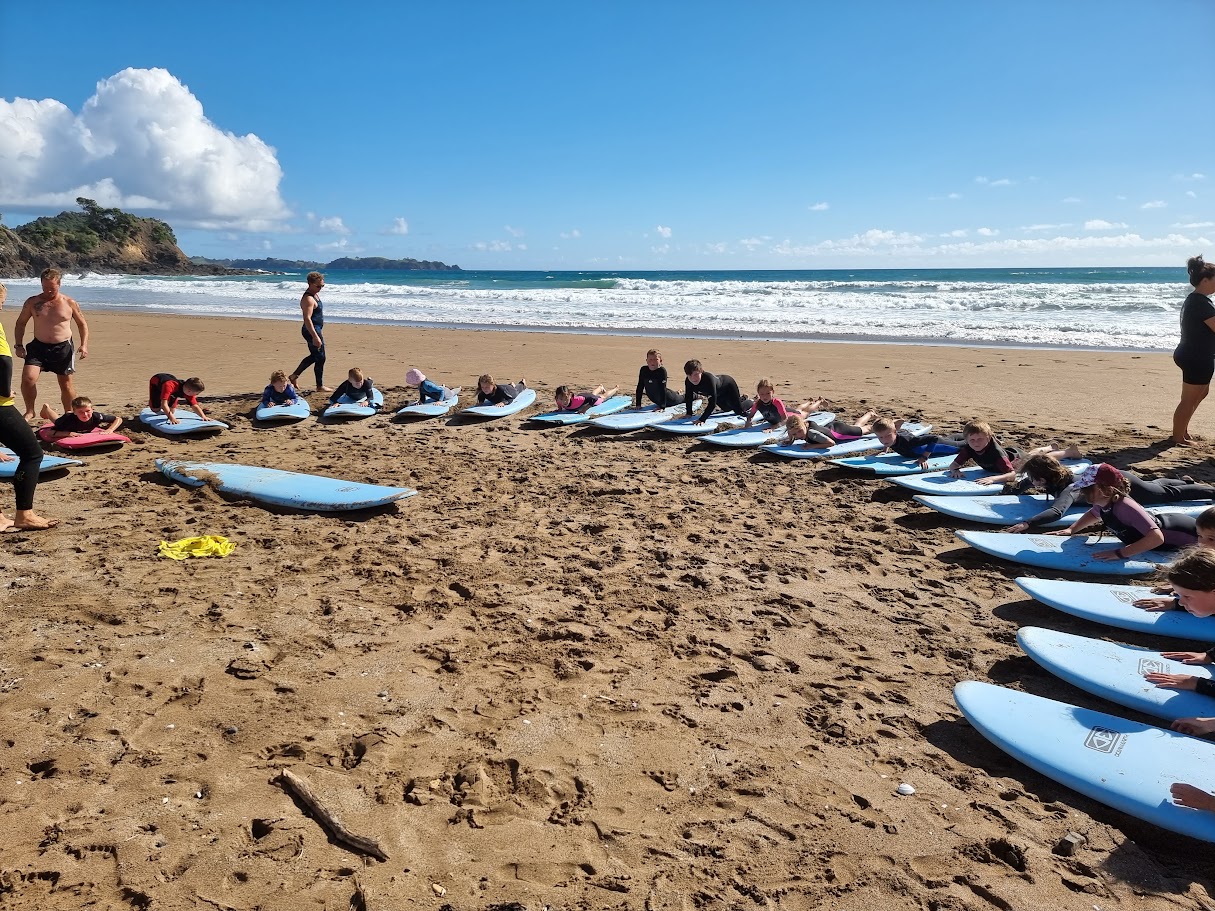Tutukaka Cove: An Open Ocean Beach
Off Rauhomaumau Road, south of Tutukaka, lies a stretch of coastline that locals call Dolphin Bay, though the official name is Tutukaka Cove. This is not your typical Tutukaka Coast beach experience. Unlike the sheltered harbour beaches or white sand of Matapouri Beach, Tutukaka Cove offers something raw, exposed, and distinctly different, a black sand and pebble beach that faces the full force of the Pacific Ocean.
Located approximately 30km (19 miles) from Whangārei and just 3.5km (2 miles) from Tutukaka Marina, this cove sits in a unique position immediately south of the Tutukaka Harbour entrance. It’s a place that demands respect, requires effort to access, and rewards those willing to accept it on its own terms with a dramatic coastal experience unlike the more popular beaches along this renowned stretch of coastline.
Tutukaka Cove’s Character
Let’s be clear from the start about what Tutukaka Cove is and isn’t. This is an exposed, open-coast environment that receives the full brunt of southeast swells rolling in from the Pacific. On many days, particularly during rough weather or high seas, this beach is genuinely inaccessible, even from shore. The wave action can be intense, the currents strong, and the conditions challenging.
The beach composition reflects this exposed nature. Instead of the white sand on beaches like Matapouri or Whale Bay, Tutukaka Cove has black volcanic sand mixed with pebbles and broken rock fragments. This darker beach is the result of ocean waves pounding on volcanic rock over thousands of years, creating a shoreline that reflects the raw power of the ocean.
This isn’t a beach for casual family swimming or leisurely paddling. Strong swimmers might venture in on calm days, but this cove demands caution and a serious assessment of conditions and abilities. The extensive reef areas that characterise the bay make navigation difficult except in very small craft like kayaks, and even then, local knowledge and suitable conditions are essential.
However, when conditions are right, particularly when winds are from the southwest to north, Tutukaka Cove can be remarkably sheltered and beautiful. It’s this variability, this requirement to read conditions and choose your moment, that makes this beach special for those who appreciate wilder coastal environments.
The Access Track: Know Before You Go
Access to Tutukaka Cove is at the end of Rauhomaumau Road, you’ll find the starting point for a dirt and gravel track that descends approximately 200m (650 feet) down to the beach. This may not sound far, but the nature of the track means those 200m can feel longer going uphill on your return journey. The beginning of the track has no visible signage, which you’ll find once you get down off the road. Handy!
The track surface varies from hard-packed dirt to loose gravel sections, and the gradient is noticeable. You’re descending from clifftop properties down to sea level, which naturally involves a decent slope. In dry conditions with proper footwear, most people with reasonable mobility can manage this track, though it will still require some care and attention. As you make your way down the track, there is an old barbed wire fence running along the right side, so don’t reach out and grab it for support, or you’ll end up at the doctors for a tetanus jab instead of the beach!
Weather makes an enormous difference. After rain, sections of this track can become slippery and challenging. The combination of dirt surface, gradient, and moisture creates conditions where good footwear with proper grip becomes absolutely essential. Consider postponing your visit if there’s been recent heavy rain, or at minimum, be prepared for a more difficult and potentially hazardous descent and climb.
Pack sensibly for this access. Whatever you bring down, you’ll need to carry back up. That means thinking carefully about chilly bins (that’s a “Cooler” for Americans, “Cool box” for the Brits, “and “Esky” for the Ozzies), beach equipment, and supplies. Light, essential items only. Save the elaborate beach setups for more accessible locations like Whangaumu Bay.
Native Bush: Karo, Flax, and Kawakawa
One of the pleasant surprises of the descent to Tutukaka Cove is the abundance of native vegetation that lines the track and surrounds the beach area. The coastal environment here supports thriving populations of Karo, Flax (harakeke), and Kawakawa, three distinctive New Zealand native plants that each contribute to the character of this place.
Karo (Pittosporum crassifolium) is particularly well-suited to exposed coastal environments. This hardy tree with its thick, leathery leaves and distinctive dark purple flowers provides both visual appeal and important habitat for native birds. The karo you’ll see here demonstrates the remarkable ability of New Zealand’s coastal plants to withstand salt spray and strong winds.
New Zealand flax is abundant along the track and around the cove. These impressive plants with their sword-like leaves have been essential to Māori for centuries, providing fibre for weaving, rope-making, and countless other uses. The flax here is allowed to grow naturally, creating dramatic architectural forms against the coastal backdrop.
Kawakawa (Piper excelsum) grows in the more sheltered sections of the track. This distinctive plant with its heart-shaped, often hole-riddled leaves is both culturally significant and medicinally valuable in traditional Māori healing. The holes in the leaves are caused by a native looper caterpillar and are actually a sign of a healthy kawakawa plant.
Cliff Safety: A Serious Consideration
The cliffs surrounding Tutukaka Cove present a hazard visitors need to understand. There is a genuine risk of falling rocks from these cliffs, and this risk increases after heavy rain or during strong winds. These are not solid, stable rock faces, they’re subject to constant weathering, and the slow process of erosion. Rocks do fall, ranging from small stones to larger, potentially dangerous chunks. While major rock falls are relatively rare, smaller debris comes down regularly enough that you need to be aware and cautious.
Never position yourself directly beneath overhanging sections of cliff or in areas where the cliff face appears unstable or fractured. Be particularly careful about where you set up if you’re spending extended time at the beach. A spot that seems fine initially might be directly below a section of deteriorating cliff.
Watch and listen. If you hear cracking sounds, see dust or small rocks falling, or notice any signs of instability, move away from the cliff face immediately. Teach children to stay away from the base of cliffs and never to climb on or dig at cliff faces, which can destabilise already fragile sections.
This isn’t meant to be alarmist, many visitors enjoy Tutukaka Cove safely by being aware and sensible about cliff hazards. But the risk is real and needs to be taken seriously. Unlike more developed beaches where hazards are often signed and managed, here you’re responsible for your own risk assessment and safety decisions.
Private Property Access: Respect Boundaries
As you descend the track and explore the beach area, you’ll notice multiple private access ways leading up from the beach to clifftop homes. These are clearly private driveways, paths, and tracks that provide residents with access to their properties from the beach. Do not venture up these private accesses under any circumstances. They’re not public paths, they’re not alternative routes, and they’re not shortcuts. They’re private property boundaries, and using them is trespassing.
If you’re unsure whether a particular path or track is private, assume that it is. The designated public access is the 200m track from the end of Rauhomaumau Road. Everything else is private property unless explicitly marked otherwise.
The Beach Experience: Black Sand and Exposed Coast
Once you’ve navigated the access track and established yourself safely away from cliff hazards, you can appreciate what makes Tutukaka Cove distinctive. The black volcanic sand and pebble beach stretches along this exposed section of coast, bordered by extensive reef areas that become visible at lower tides.
The reef areas are extensive and provide important habitat for marine life, but they also make the bay shallow and difficult to navigate. At low tide, the reef exposure increases dramatically, creating tide pools and rocky alcoves that are fascinating to explore, though the exposed nature of the coast means you need to remain aware of tide times and incoming swells.
Swimming here requires strong skills and good judgment. The open ocean exposure means currents can be significant, and the reef areas create variable depths and potential hazards. On calm days when conditions are from the southwest to north, experienced swimmers might enjoy the cove safely. On rough days or with southeast swells, the water is simply too dangerous for swimming.
Some visitors come primarily for fishing or exploring the rocky areas rather than swimming. The reef systems and exposed location create good fishing opportunities, though always from safe positions away from wave impact zones.

Weather and Conditions: Timing Is Everything
More than almost any other beach on the Tutukaka Coast, success at Tutukaka Cove depends on arriving during the right conditions. This is not a beach you can casually visit any day of the year and expect to enjoy safely.
Southeast swells make this cove dangerous and often completely inaccessible. The exposed position means these swells hit directly, creating large waves, strong currents, and hazardous conditions. If the forecast includes significant southeast swell, don’t go. It’s that simple.
Conversely, winds from the southwest to north provide the sheltered conditions where Tutukaka Cove can be remarkably pleasant. The clifftop properties and headlands offer some protection from these directions, and the cove can be relatively calm and enjoyable.
Summer generally offers more settled conditions and warmer water temperatures, but winter storms can be spectacular to observe from safe vantage points, not from the beach itself. Autumn often provides excellent conditions with stable weather patterns and reduced visitor numbers.
Facilities? Er… No.
Tutukaka Cove has absolutely no facilities. There are no toilets, no rubbish bins, no picnic tables, no parking areas with signage, and no lifeguard patrol. This is as close to a completely unmanaged beach experience as you’ll find on this part of the coast.
The end of Rauhomaumau Road provides very limited roadside parking, essentially space for just a few vehicles. There’s no formal car park, no turning area, and certainly no amenities. You’ll need to park considerately without blocking driveways or resident access, which can be challenging when space is tight.
Plan to be completely self-sufficient. Bring all the water, food, and supplies you’ll need. Carry out everything you bring in, every piece of rubbish, every food wrapper, every bottle. There’s nowhere to dispose of waste here, and leaving it is both environmentally destructive and disrespectful to residents.
Bathroom facilities? The nearest are back at other beaches like Whangaumu Bay or at Tutukaka Marina. Plan accordingly before making the descent to the beach.
The lack of facilities is actually part of what keeps this beach uncrowded. The access challenges and absence of infrastructure mean that only those willing to make the effort and accept the lack of amenities will visit, naturally limiting numbers and helping preserve the wild character of the place.
Marine Life and Environment
The exposed nature of Tutukaka Cove and its extensive reef systems create interesting marine habitats. The tide pools in the reef areas can be remarkably diverse, hosting various species of small fish, crabs, sea stars, and anemones. For those interested in marine life observation, low tide offers the best opportunities for exploring these pools.
The area has been noted for extensive growths of sea rimu (Caulerpa flexilis), a native seaweed particularly abundant in the shallow areas close to shore. This seaweed provides important habitat and food for various marine species and is part of the complex ecosystem that makes this coastline so biologically rich.
Dolphins are occasionally sighted in the area, particularly near the harbour entrance. While the “Dolphin Bay” name might suggest they’re constant residents, sightings are opportunistic rather than guaranteed. Other marine life, including various fish species, can be observed by snorkellers during calm conditions, though the exposed nature and reef areas mean snorkelling here is for experienced participants only.
If you’re exploring tide pools or reef areas, follow leave no trace principles. Don’t remove any creatures or shells, replace rocks carefully if you’ve lifted them to look underneath, and avoid walking on living coral or seaweed beds when possible. Treat this marine environment as the precious ecosystem it is.
Access from Tutukaka Marina and Broader Context
Tutukaka Cove’s location just 3.5km (2 miles) from Tutukaka Marina places it in an interesting position. You’re close enough to benefit from the marina’s restaurants, shops, and facilities, yet you’re accessing a beach that feels far more remote and wild than that proximity would suggest.
The marina area offers all the amenities Tutukaka Cove lacks: cafes and restaurants including Schnappa Rock and Marina Pizzeria, a general store for supplies, dive shops for those interested in Poor Knights trips, and proper facilities including toilets and parking. Many visitors combine a Tutukaka Cove visit with a stop at the marina, either before or after their beach time.
Other nearby beaches include Kowharewa Bay (just 1km or 0.6 miles away), Pacific Bay, and Whangaumu Bay (2.4km or 1.5 miles). Each of these offers very different beach experiences, from sheltered harbour swimming to longer stretches of sand, and all have easier access than Tutukaka Cove.
The proximity to Tutukaka Marina also means you’re near the departure point for diving and fishing charters to the Poor Knights Islands, one of the world’s top dive destinations. For many visitors, a Tutukaka Coast trip includes diving the Poor Knights, exploring various beaches including this one, and enjoying the marina facilities, creating a diverse coastal experience.
Conservation Considerations
Several properties along Rauhomaumau Road include conservation covenants protecting springs and wetland areas. These protected zones are important for maintaining water quality, providing habitat for native species, and preserving the natural character of the coastal environment.
Visitors should be aware that the entire coastal area, not just specific covenant properties, deserves careful treatment. The native vegetation, the marine ecosystems, and the natural processes that shape this coastline all depend on people treating the environment with respect.
Don’t damage or remove native plants. Don’t feed wildlife. Don’t leave any trace of your visit beyond footprints in the sand. Don’t disturb nesting birds if you encounter them. Don’t carve or paint on rocks or cliff faces. The standard leave no trace principles apply here with particular importance given the lack of management or maintenance.
Who Should Visit Tutukaka Cove
This beach isn’t for everyone! If you want easy access, family-friendly swimming, white sand, facilities, and reliably calm conditions, choose Matapouri, Whale Bay, or the harbour beaches instead. They’re excellent options that will suit those preferences perfectly.
Tutukaka Cove is for people who:
- Accept and appreciate wild, exposed coastal environments
- Are comfortable with challenging access and no facilities
- Can accurately assess ocean conditions and their own capabilities
- Want to experience a less developed, more raw stretch of the Tutukaka Coast
- Are prepared to visit during appropriate weather conditions only
- Respect private property and natural environments
- Are physically capable of managing the access track
Strong swimmers might enjoy swimming here during calm conditions, though many visitors find the exposed nature and reef areas make this more of a beach for exploring, fishing, or simply experiencing a different type of coastal environment than actual swimming.
Photographers, nature enthusiasts, those seeking solitude, and people wanting to understand the full spectrum of the Tutukaka Coast (not just the picture-perfect white sand beaches) will find value in the effort required to visit Tutukaka Cove.
Safety Summary
Given the multiple hazards associated with Tutukaka Cove, here’s a consolidated safety checklist:
- Check marine forecast for swell direction and conditions, avoid southeast swells
- Wear proper footwear with good grip for the dirt and gravel track
- Stay clear of the barbed wire fence on the track’s right side
- Position yourself away from cliff faces due to falling rock risk
- Avoid visiting after heavy rain, storms, or earthquakes when cliff stability is compromised
- Only swim if you’re a strong swimmer and conditions are genuinely calm
- Never venture up private property accesses from the beach
- Carry out all rubbish, there are no disposal facilities
- Plan bathroom breaks around the absence of toilets
- Be flexible about parking, arrive prepared to potentially not find space
If you’re uncertain about any aspect of conditions, access, or safety, choose a different beach. The Tutukaka Coast has numerous options that may be more suitable alternative for the day’s conditions or your capabilities.
If you’re willing to check conditions carefully, manage the access challenges, accept the lack of facilities, avoid private property accesses, stay clear of cliff hazards, and appreciate this beach for what it is rather than wishing it were something else, Tutukaka Cove can be a memorable addition to your Tutukaka Coast exploration.
Just remember that 200m dirt and gravel track. What goes down must come back up, and that climb at the end of your visit, particularly if you’ve spent hours at the beach, can be genuinely challenging. Pack light, prepare properly, and save some energy for the return journey. The view from the top, looking back over the cove you’ve just experienced, makes it worthwhile.
And whatever you do, mind that barbed wire fence on the right as you’re heading down.











